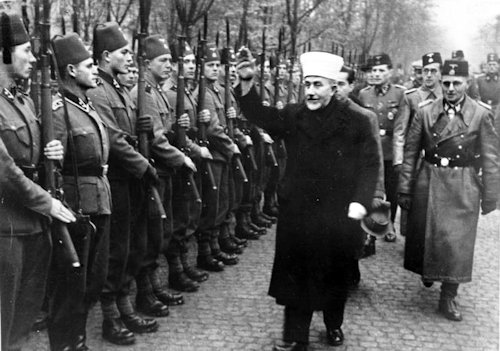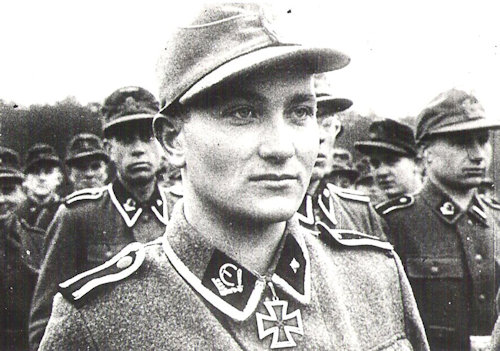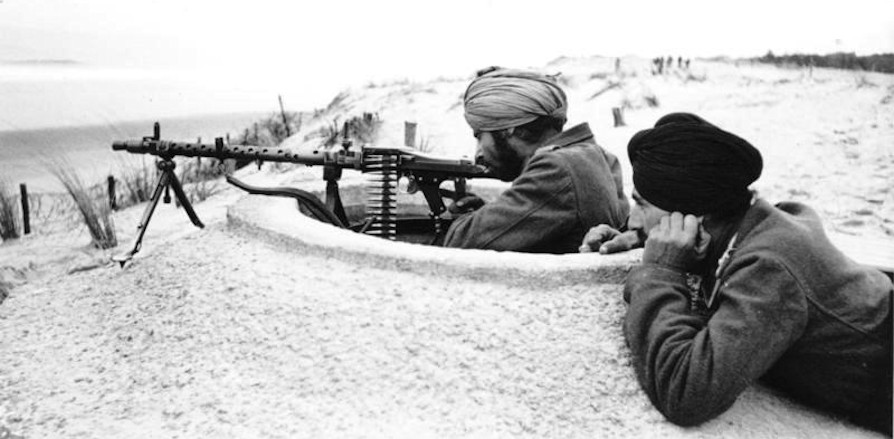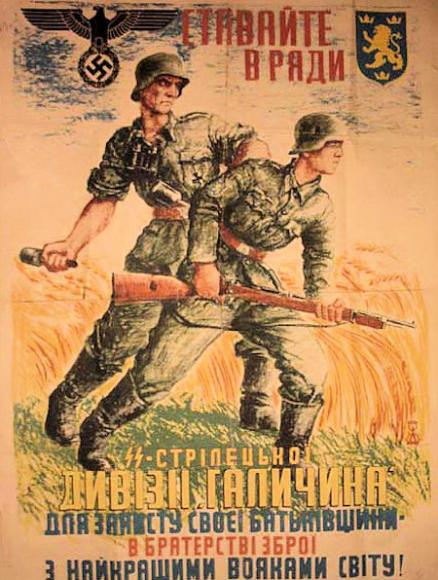The SS was created by Adolf Hitler in the 1925 officially to perform a Fuhrer personal defense function and to watch party rallies; this restricted and selected circle of fighters became over time a military organization whose sad reputation became as its line that in the period of greater engagement on the fronts of war counted nearly one million fighters of various nationalities.
It is appropriate to divide the SS into three categories: the Allgemeine SS, those of the first time that Himmler considered the true SS nationalists of the national socialist state, the SS Verfugungstruppe that they became Waffen-SS and were made up of fighters of various nationalities and the SS-Totenkopfverbände of service in the concentration camps.
As Known SSs were sentenced 30 September 1946 to the Nuremberg trial as a criminal organization for the brutality committed during World War II, one of the peculiarities that distinguished it was the ideological involvement of its affiliates who wished for a Europe built on dictatorial principles and the Heavenly Teutonic order in the old continent and in the world.
Surprisingly, as long as the SSs have been involved in the fighting of many nations and religions in their combat units, from a purely military point of view they can be considered a kind of "first European army" given the multiethnicity of their troops but it must be said who adhered to the waffen-ss not just Aryans but also simple Anti-Semites and Anti-Bolsheviks, along with those who preferred enlisting to the likely concentration camp.
Eastern Europe involved a total of almost 400.000 SSs, including: Hungarian 80.000, 50.000 Cossacks, Czechoslovakia 45.000, Croatian 45.000, Latvian 35.000, Ukrainian 30.000, Estonian 20.000, Croatian 20.000, Serbian 20.000, Romanian 13.000, Belarussian 12.000, 8.000 Poles, 5.000 Albanians, 3.000 Bulgarians.
Eastern Europe gave the biggest boost to the multiethnicity of the SS, during the rafts the most disrupted divisions were those made up of Russians and Croats who went to history for their own frustration.
Let's look at the Eastern European SS divisions.
La 7. SS Freiwilligen-Gebirgs-Division "Prinz Eugen" born on March 1st 1942 composed exclusively of Croatian, Serbian and Transylvanian elements. He was employed in Yugoslavia and participated among other things in September of 1943 at the disarmament of Italian units in the Ragusa-Metkovic-Split area; in the 1944 attacked the headquarters of Tito by working against the partisans. It was formed by three Alpine regiments, two artillery squadrons, and other wards. Along with other units of the waffen SS he created a bridge to allow the retreating of German 350.000 soldiers in Greece who had been surrounded by Soviets near the corridor of Vardar, Macedonia.
They were responsible for the massacre of Trilj, where the officers of Bergamo perished.
 La 13. Waffen-Gebirgs-Division SS "Handschar" formed in February 1943 by Croats of Muslim religion (in the time Bosnia was part of Croatia) was used against the partisans and the headquarters of Tito, Hungary and Austria. It consisted of two Alpine regiments, a cavalry battalion, a battalion of cyclists and other wards. The peculiarity of this division lies in the fact that they were all Muslims enlisted by Himmler in concert with the Grand Mufti of Jerusalem and the consent of Adolf Hitler; the chosen ones were identified in the ranks of JMO and JMM Islamist networks that formed the mosaic of Bosnian Muslim politics. The symbol was the scimitar and the white swastika on a black background; the fighters wore the distinctive green fez.
La 13. Waffen-Gebirgs-Division SS "Handschar" formed in February 1943 by Croats of Muslim religion (in the time Bosnia was part of Croatia) was used against the partisans and the headquarters of Tito, Hungary and Austria. It consisted of two Alpine regiments, a cavalry battalion, a battalion of cyclists and other wards. The peculiarity of this division lies in the fact that they were all Muslims enlisted by Himmler in concert with the Grand Mufti of Jerusalem and the consent of Adolf Hitler; the chosen ones were identified in the ranks of JMO and JMM Islamist networks that formed the mosaic of Bosnian Muslim politics. The symbol was the scimitar and the white swastika on a black background; the fighters wore the distinctive green fez.
La 14 Waffen-Granadier-Division of SS (Ukrainische nr 1) born in the winter of 1943 and formed by Greek-Catholic Ukrainians in Galicia. It was used against the partisans in Russia, Slovakia and Yugoslavia and consisted of three regiments of volunteers, a battalion of cyclists, an Alpine artillery regiment and other departments.
The idea of the formation of this division came to the Ukrainian minority of Galicia who hoped in a statement by the Third Reich as the only hope for the subsequent formation of an independent Ukrainian state; the Germans first doubted then ended up accepting it because of the serious losses suffered at the beginning of the 1943 (v. photo opening manifesto); the district governor of the District of Galicia, Dr. Otto von Watcher, created the division of volunteers assigned to the eastern front fight under the command of German officers and sporadic attendances of Ukrainian officers.
Among the charges brought to this division is the massacre of Huta Pieniacka and the suppression of the revolt at Warsaw Ghetto in 1944.
La 15 Waffen-Grenadier-Division der SS (Lettische nr 1) born in February 1943 and formed by Latvians. He was employed in Russia against the partisans and then in Germany. It was made up of three regiments, a battalion of rifles, a wagon hunt, an artillery regiment, and other wards. This division was born when the Latvian volunteer brigade was elevated to the rank of division and sent to the front in November 1943, the Soviet offensive forced the Nazi authorities to transfer it to Eastern Prussia, but was sent back to the front in January 1945 where he continued to fight against Soviet troops until the end of hostilities.
La 19 Waffen-Grenadier Division (Lettische nr 2) born in January 1944 and formed by Latvians after the elevation to division of the volunteer brigade "Lettische SS-Freiwilligen-Brigade. He was employed in Russia during the siege of Leningrad and then in Curland under the control of the North Armament Group and then of the Curlandia Armed Group; in this region he fought until the end of the war surrendering to the Red Army.
 La 20 Waffen-Grenadier-Division of SS (Estnische nr 1) born in February 1944 and formed by Estonian volunteers; was employed in Russia and Germany, consisted of two regiments, a battalion of riflemen, an artillery regiment and other wards.
La 20 Waffen-Grenadier-Division of SS (Estnische nr 1) born in February 1944 and formed by Estonian volunteers; was employed in Russia and Germany, consisted of two regiments, a battalion of riflemen, an artillery regiment and other wards.
In the rising division, elements of other battalions of volunteers were joined to form a force capable of defending the bridge over the Narva under strong Soviet pressure; after days of long fights the mission was accomplished and the Russians were rejected beyond the river, but the Soviet offensive did not wait and when the Red Army was about to invade Estonia Hitler approved the idea of abandoning the nation and fold back west, but many patriots were not given for victory and began a heroic resistance under the insignia of the Forest brothers judged a patriotic resistance even by war-end Americans; this division was animated by a strong anti-Soviet feeling, for the Estonians the Third Reich could be salvation from Soviet clutches but did not go according to the aspirations of the Baltic people.
According to the malignant, the symbol of the Estnische nr 1 a white "E" on a black background identical to the Euro symbol, is evidence of alleged and hypothetical monetary subjugation strategies perpetrated in Europe by Germany in modern times; but they are only rumors that we report for the record.
La 21 Waffen-Gebirge-Division of SS "Skanderberg" (Albanische nr 1) was born in the spring of 1944 and was formed by Albanians and Kosovars. It was used on-site against the partisans and was then integrated by officers, non-commissioned officers and Nazi sailors of the Aegean Nazi fleet. It was made up of two regiments of alpine hunters, an alpine artillery regiment and other wards.
The high percentage of deserters imposed the dissolution, what remained of the Albanian forces, the Kampfgruppe Skanderberg was aggregated to the SS-Gebirgs-Division "Prinz Eugene".
La 23 Waffen-Gebbirgs-Division der SS "Kama" (Kroatische nr 2) the 10 was born June 1944 and was formed by Muslim Croats; was employed in Hungary and Croatia and consisted of two regiments of alpine hunters and a mountain artillery regiment.
The 24 1944 September after only three months from its birth the Red Army puts an end to the history of this division breaking down to the West and requiring the transfer of the division to the front; the inadequacy of the armaments and the improvisation with which the Kroatische nr.2 was born marked the birth of the destiny of the division that strenuously fought against the Russian-Bulgarian forces but was severely hit in Skopje and had to be withdrawn and reorganized to oppose the we held the forces of the Soviets near Belgrade but were annihilated by Titoist and Russian troops who did not take prisoners: they were all eliminated.
 La 25 Waffen-Grenadier-Division of SS "Hunyadi" (Ungarische nr 1) was born in November 1944 and is formed by Hungarian volunteers (photo); was used in Hungary and Germany, consisted of three regiments of grenadier, an artillery regiment, a battalion of skiers.
La 25 Waffen-Grenadier-Division of SS "Hunyadi" (Ungarische nr 1) was born in November 1944 and is formed by Hungarian volunteers (photo); was used in Hungary and Germany, consisted of three regiments of grenadier, an artillery regiment, a battalion of skiers.
This division arose following the overthrow of the Hungarian government of Admiral Horthy, who planned a secret armistice with the USSR; a German fascist fascist regime was born, directed by Ferenc Szalasi, leader of the silver cross movement.
Immediately the formation of the new division that began training in November 1944, in January 1945 were over 20.000 men in the Neuhammer training camp in Germany where a month after the troops of the Red Army expelled the small group of neo SSs covered the evacuation of the rest of the division in Austria.
The bulk of the division surrenders on Austrian soil to US forces.
La 29 Waffen-Grenadier-Division (russische Nr. 1) was born in December 1941When Lokot's mayor, Ivan K. Voskobinkov, ordered a militia to arrest the Soviet partisans' attacks on the railways in the area.
After the debut of numerous successes, the Red Army's advance caused mass delusions in the mining division also by infiltration operations; the repression was tough and some dissident officials were hanged. The Germans pushed the ranks but the defeat in the battle of Kursk forced the brigade to retreat to Belarus.
This Division began with about 500 units in December of the 1941, peaked in September of the 1943 when it was made up of just under 15.000 units and then fell on the negative wave of war on 5.000 units in July of the 1944; when he surrendered in March 1945 was now decimated.
The 29 number will be resumed in March 1945 for the creation of another division that will remain in the story and will be dealt with in the next and final SS article.
The birth of this division is late, the fate of the war was already marked but the elements that compose it have fought hard to the end.
In addition to the above mentioned divisions, the following legions should be emphasized:
Lettische SS- Freiwilligen-Legion (Latvian volunteers)
Lettische SS-Brigade 2 (Latvian volunteers)
Lettische Freiwilligen-SS-Brigade (Latvian volunteers)
Waffen-Gebirgs-Brigade der SS (Tartarische nr 1) (Crimean Tatars volunteers)
Ostturkischer Waffen-Verband der SS (Turkish volunteers)
Serbisches Freiwilligen-Korps (Serbian volunteers)
Waffen-Grenadier-Regimenter der SS (Romanian number 1 und 2) (Serbian volunteers)
Waffen-Grenadier-Regiment der SS (Bulgarische) (Bulgarian volunteers)
Indische Legion (Indian volunteers from Subhas Chandra Bose, photo below)
 (photo: web)
(photo: web)












